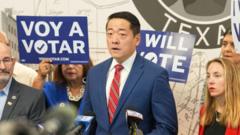**The redistricting skirmish between California and Texas ignites concerns over electoral fairness and minority representation.**
**Redistricting Wars: California and Texas Engage in Political Tug-of-War**

**Redistricting Wars: California and Texas Engage in Political Tug-of-War**
**Intense battles over congressional district maps threaten the balance of power in Washington.**
In an escalating political contest, California and Texas, the two largest states in the U.S. by population, are engaged in a fierce battle over redistricting that could reshape the landscape of congressional representation ahead of the national midterm elections next year. Texas recently implemented a redistricting plan that creates five additional congressional seats advantageous to Republicans, prompting California lawmakers to act swiftly in response by proposing a map designed to counter Texas' maneuver.
This redistricting conflict began in Texas, where the Republican-led legislature chose to redraw congressional seat lines mid-decade, a tactic intended to bolster Republican representation in the House. In an unprecedented move, California retaliated by drawing up its own maps aimed at increasing Democratic representation by a similar margin. These new boundaries are expected to go to voters in a referendum this November.
Understanding redistricting in the U.S. requires visualizing how 435 representatives are tasked with reflecting America's demographic shifts. This task can be influenced significantly by who gets to delineate the district lines—some states utilize non-partisan commissions, while others enable state legislatures to dictate the outcome. The political stakes are especially high now, as Democrats are on the cusp of potentially flipping the House if they can secure the crucial seats they need.
The current political climate is heightened by the impending midterm elections, where traditionally, the party in power tends to lose congressional seats. Since former President Donald Trump's call for Republican statehouses to rally and bolster their party's stronghold, redistricting has come under scrutiny, particularly with allegations of gerrymandering surfacing. Critics contend that such practices undermine electoral integrity by allowing politicians to manipulate district boundaries to favor their own interests.
While the legality of gerrymandering remains intact unless deemed racially motivated, it has sparked widespread debate. Civil rights advocates claim that Texas' redistricting plans threaten to disenfranchise minority voters, potentially violating federal laws. Ironically, this partisan clash has laid bare the political intentions behind redistricting, as public acknowledgment of these motives becomes increasingly common.
With potential repercussions extending into the 2026 midterm elections, various states are now gearing up to adapt their district maps to either support or counter these initiatives. Democratic states like Illinois and New York have expressed plans to introduce measures against Texas' redistricting, while Republican-held states are pursuing similar strategies to enhance their influence.
In California, Governor Gavin Newsom has vowed to engage in this political retaliation by replicating Texas' approach, albeit navigating a slower legislative process aimed at curbing partisan influences. Meanwhile, New York's redistricting efforts face additional hurdles as constitutional changes are required.
Ultimately, as both parties strategize to position themselves advantageously through manipulated district lines, the future shape of Congress—and the legacy of Trump's political agenda—hangs in the balance of this ongoing showdown.
This redistricting conflict began in Texas, where the Republican-led legislature chose to redraw congressional seat lines mid-decade, a tactic intended to bolster Republican representation in the House. In an unprecedented move, California retaliated by drawing up its own maps aimed at increasing Democratic representation by a similar margin. These new boundaries are expected to go to voters in a referendum this November.
Understanding redistricting in the U.S. requires visualizing how 435 representatives are tasked with reflecting America's demographic shifts. This task can be influenced significantly by who gets to delineate the district lines—some states utilize non-partisan commissions, while others enable state legislatures to dictate the outcome. The political stakes are especially high now, as Democrats are on the cusp of potentially flipping the House if they can secure the crucial seats they need.
The current political climate is heightened by the impending midterm elections, where traditionally, the party in power tends to lose congressional seats. Since former President Donald Trump's call for Republican statehouses to rally and bolster their party's stronghold, redistricting has come under scrutiny, particularly with allegations of gerrymandering surfacing. Critics contend that such practices undermine electoral integrity by allowing politicians to manipulate district boundaries to favor their own interests.
While the legality of gerrymandering remains intact unless deemed racially motivated, it has sparked widespread debate. Civil rights advocates claim that Texas' redistricting plans threaten to disenfranchise minority voters, potentially violating federal laws. Ironically, this partisan clash has laid bare the political intentions behind redistricting, as public acknowledgment of these motives becomes increasingly common.
With potential repercussions extending into the 2026 midterm elections, various states are now gearing up to adapt their district maps to either support or counter these initiatives. Democratic states like Illinois and New York have expressed plans to introduce measures against Texas' redistricting, while Republican-held states are pursuing similar strategies to enhance their influence.
In California, Governor Gavin Newsom has vowed to engage in this political retaliation by replicating Texas' approach, albeit navigating a slower legislative process aimed at curbing partisan influences. Meanwhile, New York's redistricting efforts face additional hurdles as constitutional changes are required.
Ultimately, as both parties strategize to position themselves advantageously through manipulated district lines, the future shape of Congress—and the legacy of Trump's political agenda—hangs in the balance of this ongoing showdown.





















